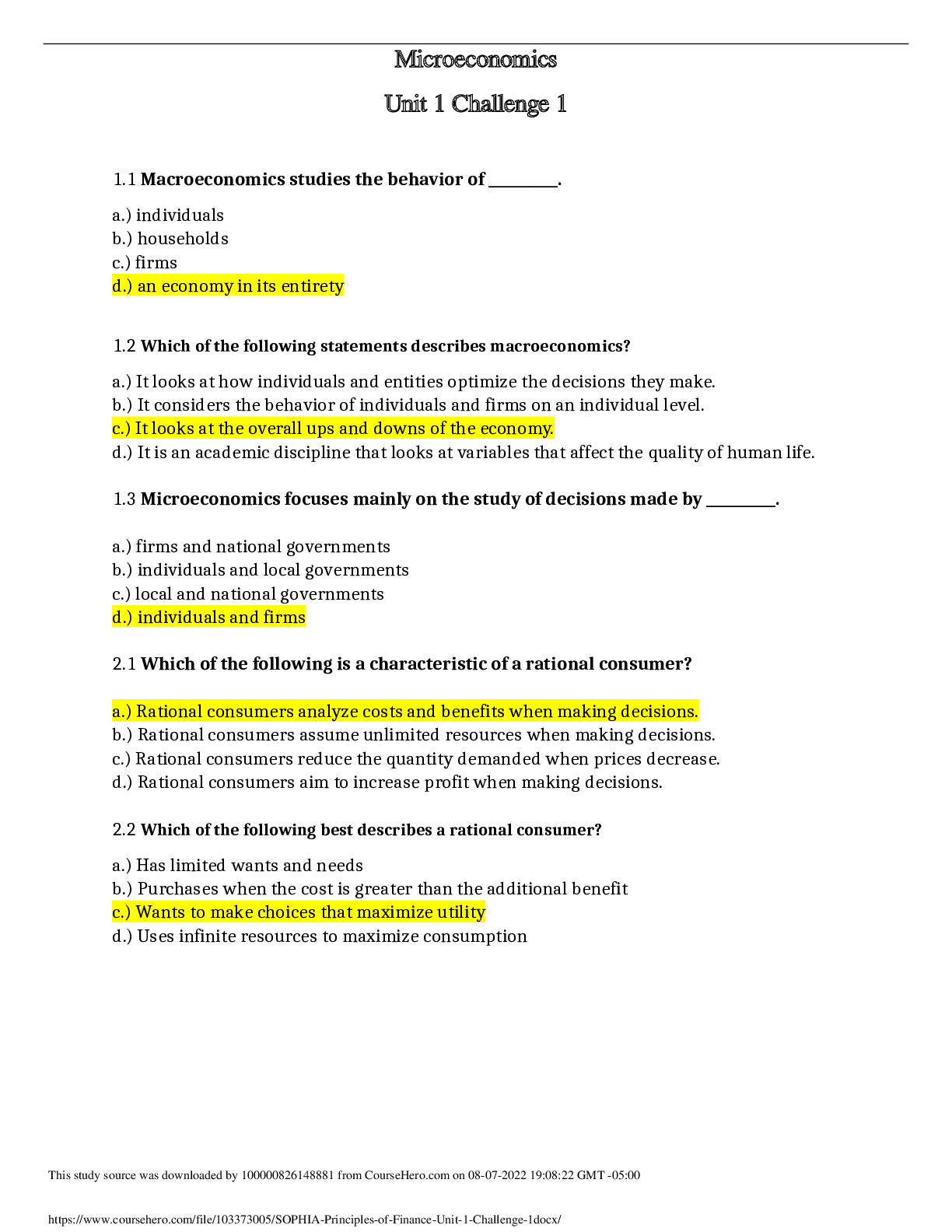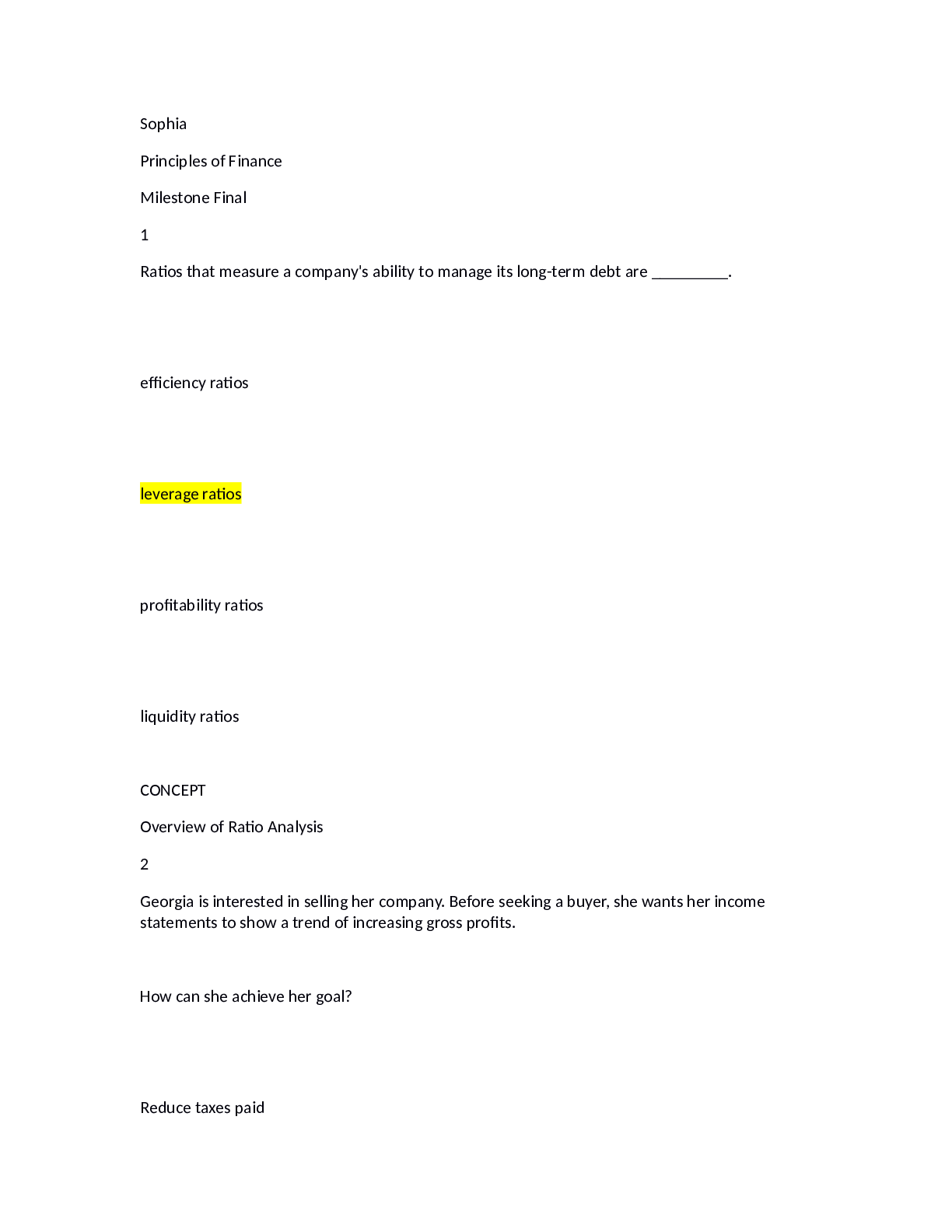Economics > QUESTIONS & ANSWERS > FIN 320 SOPHIA Principles of Finance Unit 1 Challenge 1 Microeconomics Exam (All)
FIN 320 SOPHIA Principles of Finance Unit 1 Challenge 1 Microeconomics Exam
Document Content and Description Below
Southern New Hampshire University FIN 320 SOPHIA Principles of Finance Unit 1 Challenge 1 Microeconomics Unit 1 Challenge 1 1.1 Macroeconomics studies the behavior of __________. a.) individuals ... b.) households c.) firms d.) an economy in its entirety 1.2 Which of the following statements describes macroeconomics? a.) It looks at how individuals and entities optimize the decisions they make. b.) It considers the behavior of individuals and firms on an individual level. c.) It looks at the overall ups and downs of the economy. d.) It is an academic discipline that looks at variables that affect the quality of human life. 1.3 Microeconomics focuses mainly on the study of decisions made by __________. a.) firms and national governments b.) individuals and local governments c.) local and national governments d.) individuals and firms 2.1 Which of the following is a characteristic of a rational consumer? a.) Rational consumers analyze costs and benefits when making decisions. b.) Rational consumers assume unlimited resources when making decisions. c.) Rational consumers reduce the quantity demanded when prices decrease. d.) Rational consumers aim to increase profit when making decisions. 2.2 Which of the following best describes a rational consumer? a.) Has limited wants and needs b.) Purchases when the cost is greater than the additional benefit c.) Wants to make choices that maximize utility d.) Uses infinite resources to maximize consumption 2.3 Ben was offered a full-time position working on his uncle's construction crew and would be paid $20 per hour. Instead, Ben chose to take classes at the local college so he could finish his degree. In economic terms, this loss of potential income is known as a(n) __________. a.) opportunity cost b.) cost/benefit analysis c.) utility maximization d.) marginal utility 3.1 Economists assume that all rational consumers will allocate their resources in order to __________. a.) maximize their income b.) incur the lowest costs c.) maximize their utility d.) have the greatest number of choices 3.2 Terry currently works a part-time evening job on campus. With this job, he has free time on the weekends to hang out with his friends and catch up on school work. However, a nearby shoe store, Speedy Feet, is hiring for $10/hour. He would be able to earn a higher income and a significant discount on running gear that he would be buying anyway. Terry has to take into consideration which of the following economic principles when deciding whether to forego his current job at the university in favor of a job at the shoe store? a.) Production constraints b.) Labor/leisure trade-off c.) Explicit cost d.)Utility maximization 3.3 Which of the following statements is true as it relates to labor/leisure trade-off? a.) It is necessary to consider the resources necessary for production with a labor/leisure trade-off. b.) It is the comparison of time spent working to time spent participating in non-work activities. c.) Everyone has the same labor/leisure trade-off. d.) If someone works a lot it can be assumed they have a lot of leisure time too. 4.1 Sarah is deciding between two different pairs of running shoes: The Minimalist 7, which cost $99, and the Sprint XT, which are priced at $155. Although both would meet her needs, Sarah knew that she would get more wear and more support out of the higher-priced Sprint XT shoe. If she wanted to buy the shoes today, Sarah had the ability to pay $99 for the Minimalist 7s. However, if she wanted to buy the Sprint XTs, she would need to pick up another shift at her job to earn the extra money. Which of the following statements describes the marginal cost? a.) Sarah wants the higher-quality shoes. b.) Sarah does not have $155. c.) Sarah's desire to buy new shoes will decrease, because she will not have as much free time to run. d.) Sarah must work another night. 4.2 Paul is deciding between two different types of winter jackets: The Classic, which costs $120, and the Extreme, which is priced at $195. Although both would meet his needs, Paul knows that he would get more wear out of the higher-priced jacket because it includes an extra layer and a hood. If Paul waits and purchases the more expensive jacket, it will provide more warmth and he will get more wear out of it, which is also known as a __________. a.) constraint b.) marginal cost c.) consumer optimization d.) marginal benefit 4.3 While helping Kyle choose new shoes, the running store owner, Juan, learned that Kyle runs primarily in the evenings and is allergic to formaldehyde, a chemical found in most wool. He also learned that Kyle does not like energy drinks, as they upset his stomach. Juan recommended that Kyle should buy new shoes every six months, otherwise the tread can wear down quickly and start to cause injuries. Juan suggested that, for only $5, Kyle should join the store running club, where he can receive members-only coupons and a choice of four benefit options. Determine which of the following options would provide any benefit to Kyle. a.) A 10% discount on wool sweaters, caps and gloves b.) A $10 gift card that can be used toward the purchase of any energy drinks c.) A frequent buyers' store discount card d.) A sale on biking shoes at a store down the street 5.1 Julie uses social media sites and word-of-mouth as much as she can when advertising for the products in her clothing store. She also sets up a booth at local events, which brings in more customers. It can be time-consuming, yet she can reach her target customers while spending as little money as possible. Julie is using the strategy known as __________ by focusing her efforts on forms of advertising that cost very little, such as social media and word-of-mouth. a.) cost minimization b.) utility maximization c.) opportunity costs d.) profit maximization 5.2 A firm decides to produce 100,000 baseballs. Which of the following would be its opportunity cost? a.) Price paid to power their factory b.) The wages paid to workers c.) The 50,000 footballs the firm could have produced otherwise d.) Price of cowhide to produce 100,000 baseballs 5.3 Firms want to adopt an output strategy that allows them to __________. a.) use the most resources b.) produce the greatest amount possible c.) hire the fewest workers d.) maximize their profits 6.1 Which of the following is an example of a labor resource? a.) The air popper used to make popcorn at a movie theater b.) The engineers who designed and created the assembly line for a manufacturing company c.) The trucks used to transport refrigerated goods to grocery stores d.) The property on which a clothing factory is located 6.2 Which of the following is the best example of mechanized capital? a.) An oven utilized in a pizza restaurant b.) Land purchased for a new factory c.) Teachers working in a classroom d.) Dividend on a stock paid to shareholders 6.3 Wage and salary contracts, leases and fixed factory sizing are all examples of __________. a.) cost minimization strategies b.) short-run production constraints c.) factors of production d.) variable costs 7.1 Which of the following is an example of marginal revenue? a.) A bicycle shop pays to keep its store open additional hours. b.) A toy store pays for another shipment of Legos. c.) A restaurant makes and sells an additional meal. d.) A clothing boutique hires an additional worker. 7.2 All profit maximizing firms will produce until __________. a.) fixed costs are covered b.) marginal revenue equals marginal cost c.) total revenue equals total cost d.) all capital is paid for 7.3 A firm that produces running shoes is currently manufacturing a line of waterproof shoes at a marginal cost of $50 per pair. During the winter months, they were able to charge a price of $90 per pair. Now that it is summer, the demand has fallen, and they are only able to charge $60 per pair. Assuming the shoe store is a profit-maximizing firm, which of the following is true? a.) The firm should continue to produce the shoes even if the price fell a lot further since that's the only way to maximize revenue. b.) The firm should continue to produce the shoes since the marginal revenue is still greater than the marginal cost. c.) The firm should shut down this production line since it is driving down its overall profitability. d.) The firm should stop producing the shoes since their profit margin is smaller than before. [Show More]
Last updated: 1 year ago
Preview 1 out of 5 pages
Instant download

Buy this document to get the full access instantly
Instant Download Access after purchase
Add to cartInstant download
Reviews( 0 )
Document information
Connected school, study & course
About the document
Uploaded On
Aug 08, 2022
Number of pages
5
Written in
Additional information
This document has been written for:
Uploaded
Aug 08, 2022
Downloads
0
Views
46



















